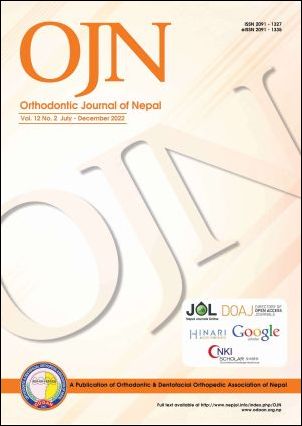Comparison of Structural Topography, Elemental Composition and Qualitative Analysis of two Indian mini-implants: A cross-sectional study
DOI:
https://doi.org/10.3126/ojn.v12i2.42906Keywords:
Orthodontics, mini-implant, topography, microstructure, titaniumAbstract
Objectives: This research was conducted to evaluate the surface topography, elemental composition and manufacturing defects of two brands of mini-implants commonly used in India. Clinical significance was derived based on the data of this research.
Materials and methods: This research was conducted on 15 orthodontic mini-implants each from two brands commonly used in India. Scanning electron microscope imaging of the head, transmucosal neck, body, and tip was done to assess mini-implant topography and manufacturing defects (n=15/group). Analysis of elemental composition was done using an X-ray Powder Diffractor (n=1/group).
Results: The results showed significant differences in both groups. Differences in structural topography of the implant body and tip were observed in both brands. Tip defects were detected in one brand. X-ray Powder Diffraction analyses revealed an alpha and alpha-beta titanium grain structure in both the groups.
Conclusions: All the mini-implants tested were composed of titanium alloy. Significant differences were found in the surface area of the threaded parts. We conclude that differences in surface topography and presence of manufacturing defects impact the primary stability of the implants thereby influencing the efficacy of orthodontic anchorage.
Downloads
Downloads
Published
How to Cite
Issue
Section
License
Copyright (c) 2022 Orthodontic & Dentofacial Orthopedic Association of Nepal

This work is licensed under a Creative Commons Attribution 4.0 International License.
Copyright © held by Orthodontic & Dentofacial Orthopedic Association of Nepal
- Copyright on any research article is transferred in full to the Orthodontic & Dentofacial Orthopedic Association of Nepal upon publication in the journal. The copyright transfer includes the right to reproduce and distribute the article in any form of reproduction (printing, electronic media or any other form).
- Articles in the Orthodontic Journal of Nepal are Open Access articles published under the Creative Commons CC BY License (https://creativecommons.org/licenses/by/4.0/)
- This license permits use, distribution and reproduction in any medium, provided the original work is properly cited.




